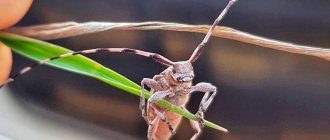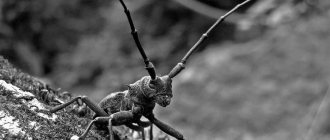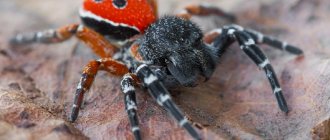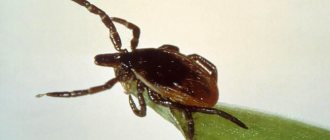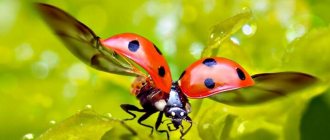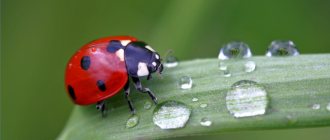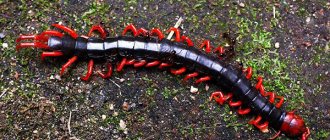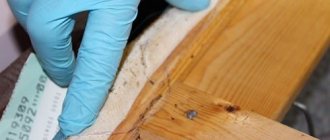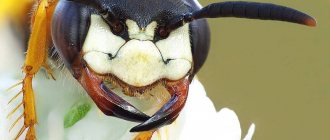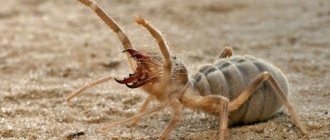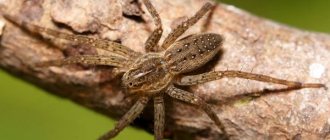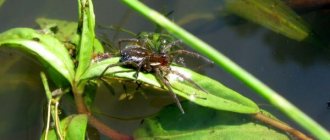Longhorned beetles or lumberjacks - a diverse family of beetles, occupying fifth place in the world of insects in terms of the number of species. The family got its name thanks to its extraordinary mustache, sometimes two to four times the length of the insect’s body. Of the 26,000 species, only 583 live in Russia, including the largest of those living in our country - Ussuri relict barbel (length up to 11 cm).
It is no coincidence that the second name woodcutter was assigned to insects. Most species feed on wood, causing great harm to forestry. Adults and larvae of insects have highly developed upper jaws, which allows them to easily gnaw through the bark and sapwood of pine trees.
The most dangerous pests of coniferous forests are considered to be large black beetles of the genus Monochamus or black longhorned beetles, among which two species play a major role in the destruction of the forest - the black pine longhorned beetle (Monochamus galloprovincialis) and the small black spruce longhorned beetle (Monochamus suto) .
Sources
- ↑ 123 Francesco Vitali. Taxonomy, systematics and synonymy (English). BioLib. Retrieved February 10, 2011.
- ↑ 1234567891011 Plavilshchikov N.N. Fauna of the USSR. Coleoptera. Woodcutter beetles. Subfamily Lamiinae part 1. Part 3. - Moscow, Leningrad: Publishing House of the USSR Academy of Sciences, 1958. - T. XXII, issue. 1. - pp. 506-508. — 575 p. — 2000 copies.
- ↑ 12345 Cherepanov A. I. Longhorned beetles of Northern Asia (Lamiinae: Dorcadionini—Apomecynini). - Novosibirsk: “Science”, Siberian branch, 1983. - P. 83-84. — 1000 copies.
- ↑ 123 Akhmatovich N. A. Silvicultural significance of tree stem nematodes and biological characteristics of the plant nematode Bursaphelenchus mucronatus. (Russian). — St. Petersburg: St. Petersburg State Forestry Academy named after. S.M.Kirova, 2007. - P. 1-22. Archived November 23, 2010.
- ↑ 12Shota Jikumaru & Katsumi Togashi. Temperature Effects on the Transmission of Bursaphelenchus xylophilus (Nemata: Aphelenchoididae) by Monochamus alternatus (Coleoptera: Cerambycidae) // Journal of Nematology. - 2000. - No. 32. - P. 110-116.
- ↑ 12Fukushige H. The number of Bursaphelenchus xylophilus carried by Monochamus alternatus and some possible factors regulating the number. (English) // Japanese Journal of Nematology. - 1990. - Vol. XX. - P. 18-24. — ISSN 0388-2357.
- ↑Troy Bartlett.Information (English). Genus Monochamus. BugGuide.net (16 February 2004). Retrieved February 12, 2011. Archived April 11, 2012.
- ↑Smith IM, McNamara DG, Scott PR & Harris KM Information (English). Data Sheets on Quarantine Pests (inaccessible link - history). VäxtEko. Retrieved February 12, 2011.
- ↑ 12William M. Ciesla.Information (English). spfnic.fs.fed.us (3 January 2007). Retrieved February 12, 2011. Archived August 17, 2011.
- Pedro Miguel Naves, Edmundo Sousa, José Manuel Rodrigues. Biology of Monochamus galloprovincialis (Coleoptera, Cerambycidae) in the Pine Wilt Disease Affected Zone, Southern Portugal (English) // Silva Lusitana. - Lisboa, Portugal: EFN, 2008. - Vol. 16, no. 2. - P. 133-148.
Professional processing
Some processing methods are best left to professionals:
- Fumigation;
- Microwave disinsection.
Each method has its pros and cons.
Fumigation
Treatment of surfaces with chemicals in the form of gases or aerosols (hot, cold or dry fog). Fogging agents are now rarely used. They do not have such high permeability as gas; it is almost impossible to destroy the larvae inside the tree in this way.
Experts use fumigation using gases with phosphides (Phostoxin and Mactoxin). They are produced in tablet form. They decompose when exposed to air and release poisonous phosphine gas. Within a day, the substance can destroy all beetles, larvae and eggs. It will take about 2 days for the gas to decompose.
Advantage of fumigation:
- 100% destruction of all parasites;
- long-term effect after treatment (10 years);
- the ability to process a large area in a short time.
The disadvantage of the method is the high toxicity of the substances.
Microwave disinsection
If the larvae and eggs are exposed to temperatures exceeding +55°C, they die. Special microwave installations have been created for this purpose. Microwave radiation is directed onto a specific surface, causing the molecules to vibrate and heat up. As a result of this effect, the parasites die. However, such radiation does not harm wood.
Advantages of the method:
- no need to evacuate people from home;
- you can quickly get rid of longhorned beetles;
- effective in all weather conditions;
The negative factor is that the work is painstaking. It is necessary to detect all the places where the parasite lives, this requires some experience. Specialists have special equipment for this – a stethoscope. They bug the house around the perimeter, each nest is treated with a radiator.
Taxonomy
See also: List of species of longhorn beetles of the genus Monochamus
The genus includes about 150 species[9][10]. Some of them:
- Monochamus alternatus Hope, 1842
- Monochamus carolinensis (Olivier, 1792)
- Monochamus clamator (LeConte, 1852)
- Bronze pine barbel (Monochamus galloprovincialis (Olivier, 1795))
- Monochamus grandis Waterhouse, 1881
- Monochamus guttulatus Gressitt, 1951
- Black spotted barbel (Monochamus impluviatus Motschulsky, 1859)
- Monochamus marmorator Kirby in Richardson, 1837
- Monochamus maruokai Hayashi, 1962
- Monochamus mutator LeConte, 1850
- Far Eastern black longhorned beetle (Monochamus nitens Bates, 1884)
- Monochamus notatus (Drury, 1773)
- Monochamus obtusus Casey, 1891
- Velvety-spotted black barbel (Monochamus saltuarius (Fabricius, 1792))
- Great spruce black beetle (Monochamus sartor (Fabricius, 1787))
- Monochamus scutellatus (Say, 1824)
- Small black spruce beetle (Monochamus sutor (Linnaeus, 1758))
- Monochamus titillator (Fabricius, 1775)
- (Monochamus urussovi (Fischer-Waldheim, 1806))
Tips for using wood structures
Recommendations:
- Inspect the wood once a year for insect damage.
- If damage is found, immediately treat with protective agents.
- Longhorned beetles love to live in damp wood. Therefore, the room must be kept dry and humidity should not be allowed to increase.
- Destruction of woodworm is a painstaking, long-term work; insects multiply intensively. For prevention, the tree needs to be treated 2-3 times. The interval between procedures is 2-3 weeks. The best time for processing is spring-summer. At this time, females lay eggs and larvae appear - the most dangerous wood pests.
- For construction, take a tree that is not infested with larvae. It's not worth saving on this. The wood must be cleared of bark.
- To prevent infection, treat the tree with a long-acting insecticidal solution before use.
- Heavily contaminated wooden structures in the house should be replaced and destroyed (preferably burned).
The appearance of longhorned beetles in the house causes a lot of worry and trouble for the owner. I am glad that today there are many means to help get rid of harmful insects. The main thing is to detect the infection in time and eliminate it. It’s better to protect yourself from the parasite in advance
If you do not pay attention to the problem in a timely manner, after some time it can become an irreparable disaster. Longhorned beetles can completely destroy a house.
Morphology
Imago
The body is always more or less elongated[2]. The head of the imago is large. There is a very deep depression between the antennal tubercles, this is especially pronounced in males, in whom the depression is very narrow and deep. The cheeks are long and usually slightly prominent at the top. Mandibles are highly developed. The eyes are strongly notched, the lower lobe of the eyes is noticeably wider than the upper lobe[2].
The antennae are more or less thin, in males they are much longer than the body, in females they are equal to the length of the body or slightly extend beyond the apex of the elytra. The first antennal segment is greatly thickened. The third segment is very long, much longer than the fourth or first. The fourth segment is slightly longer than the fifth. starting from the sixth segment, all subsequent segments are equal or almost equal in length to each other, but the 11th segment in males is very long, with a more or less clearly defined appendage; in females it is usually only slightly longer than the 10th segment[2].
The pronotum is slightly or moderately transverse, with well-defined constrictions, with large lateral tubercles elongated into sharp or very blunt splints, without tubercles on the disc. The scutellum is large, semicircular or widely rounded[2].
The elytra are long, in most cases strongly elongated, slightly narrowed towards the end or almost parallel, cylindrical, without teeth at the apex, usually rounded, almost always in rough sculpture and the main part, but without large, sharp tubercles or spines[2].
The legs are long, the femurs are linear, the tarsi are short, and the claws are opposed. The forelegs of the male are strongly elongated, longer than the hind legs, with more or less noticeably curved tibiae and widened tarsi[2].
Egg
The egg is white, elongated. The egg is rounded at the poles. Egg chorion in fine cellular sculpture[3].
Larva
The larvae are white. The head is flat, half retracted into the prothorax. The antennae are short and conical. On the ventral side of the antennae there is one convex ocellus [3].
On the anterior edge of the pronotum there is a wide white border; on the posterior edge of this border there is a transverse hairy stripe [3].
The larvae do not have thoracic legs. Motor calluses are developed on abdominal segments 1-7; motor calluses are covered with ampulla-shaped granules, which on the dorsal side form four transverse rows and one longitudinal lateral row. The anal opening consists of three rays: the lower ray is short, two to three times shorter than the two lateral ones (M. urussovi) or long, only slightly shorter than the lateral ones (M. saltuarius, M. guttulatus).
Doll
Nutrition
What the longhorned beetle eats depends on its habitat.
Adult beetles feed on pistils and stamens of flowers, young bark and leaves of bushes and trees. Pieces of fallen or healthy bark, petioles, plant sap, pulp of cacti or other plants - this is what the longhorned beetle feeds on. That is, an adult beetle is almost harmless. But the larva of the longhorned beetle is a scourge for trees, wooden buildings and wooden objects. They develop in trees and feed on wood, causing enormous harm to forests on the planet.
Many beetles were divided into subspecies precisely due to the choice of the type of tree they chose to feed their larvae. For example, the oak longhorned beetle prefers hardwood trees, oak, for example.
It can settle in oak stumps, as well as in places where the tree is damaged. This beetle is medium in size, 3 to 6 cm, black with a brown tint, and glossy like resin. The elytra are reddish at the tips. In addition to oak, he chooses beech, hornbeam, elm, and walnut for feeding future larvae.
The black or pine longhorned beetle prefers to choose coniferous trees. It is also called the ship beetle. Its larva inexorably destroyed even finished ship structures if they were built from infected pine. He himself feeds on pollen, pine needles and leaves.
The beetles that prefer coniferous trees for their clutches - larch, spruce, pine, also include the flat beetle, with a purple color.
The purple longhorned beetle itself feeds on the soft bark of young trees and tender young needles. But its larva causes damage to trees on an almost industrial scale. They continue to destroy wood, even harvested and cut for consumption. They also love to live close to humans, destroying buildings.
Description
Body length ranges from 14 to 28 mm. The elytra have a cylindrical shape without clearly defined narrowing to the apex, the body is flattened. The elytra are covered with very small rounded hairy pubescences, especially in females. The scutellum is completely divided by a smooth narrow groove. The antennae of males are 2.5 times longer than the body, and those of females are 1.5 times longer than the body.
Life cycle
The development of the beetle takes 2 years, and in unfavorable conditions it can take 3 years. The first longhorned beetles appear in May, but the main years are in June. Before laying eggs, they require additional nutrition on young twigs and needles. The fertilized female makes incisions in the bark, into which she lays white oblong eggs. Young larvae begin constructing tunnels in the bark. By autumn they go deeper into the tree trunk. The larva is white, legless, moves with the help of warts on the first 7 abdominal segments. In a special recess covered with sawdust, the larva pupates. The young beetle climbs out of the trunk through a hole in the bark.
Spreading
The black fir longhorned beetle is common in Eastern and Northern Europe, Northern and Eastern Asia. Often found in Russia, the range of this beetle includes northern, northwestern and central Eastern Europe, as well as northern Asia. The western border of the range falls on the territory of Norway, Finland, Sweden, Estonia, Latvia, Lithuania, Belarus, eastern Poland, the Czech Republic and Ukraine; southern - the northern Caucasus, the northern part of Kazakhstan, the northern regions of Mongolia and China bordering Russia, as well as the island of Hokkaido (Japan) and Korea. In the east, the barbel reaches the coast of the Sea of Okhotsk, Sakhalin and the mouth of the Amur. The northern part of the range coincides with the border of coniferous forests.
In Norway, the black fir longhorned beetle is very rare and, apparently, is imported from border countries (the ecological range is controversial). In Sweden, the species used to be distributed throughout the eastern and northeastern parts of the country - from the province of Småland to Lappmark. Now it is on the verge of extinction and is localized in the counties of Västernorrland, Västerbotten and Norrbotten. As of 2000, the last official mention of the discovery dates back to the 50s of the 20th century. In Finland, the longhorn beetle, a pest of spruce, is found in the southern and southeastern parts of the country, in Finnish Karelia.
In Latvia it is considered a critically endangered native species found in forested areas of the country. In Belarus it is found everywhere. In Ukraine, the insect can be found locally in coniferous, less often birch forests of Polesie, Ciscarpathia and the Carpathians.
In Kazakhstan, the black fir longhorned beetle is found in coniferous, mainly fir and pine forests in the east and north of the country, covering the Kostanay, North Kazakhstan, Akmola, Pavlodar and East Kazakhstan regions (“Rudny Altai”). Absent in the Tien Shan Mountains: [p. 37-40, 193].
In China, this species is well known in the north of the country and is distributed in the provinces of Heilongjiang, Jilin, Henan, Hebei, Shanxi, Xinjiang, as well as the autonomous regions of Ningxia and Inner Mongolia.
Distribution in Russia
The black fir barbel is widespread throughout almost the entire territory of Russia, being absent only in the Caucasus. Its range belongs to the trans-Eurasian Euro-Siberian-Far Eastern type: [p. 33]. Its northern habitat limit is quite arbitrary - even reaching the Arctic Circle (66°33′44″), it is essentially determined by the presence of a food supply. For example, an insect is found in Ukhta: [p. 241] (63° 34′), Shenkursk (62° 06′), the basins of the Maly and Bolshoy Yugan rivers (61°), Chukotka and the southern part of the Kamchatka Peninsula. The southern limits of the range in the European part of the Russian Federation are apparently located on the borders of the forest-steppe zone and pass through the Belgorod, Voronezh, Saratov, Samara and Orenburg regions, as well as the Republic of Bashkortostan. Some isolated specimens of longhorned beetle can also be found further south, but this may be due to the movement of wood and lumber from more northern areas.
The black fir longhorned beetle is widespread throughout the Urals, Siberia and the Far East, including Sakhalin and the Kuril Islands (here it is rare and does not cause noticeable harm).
Greater black spruce beetle Monochamus urussovl Fisch
| <,<,<, BackThe family of longhorned beetles, or woodcutters (cerambycidae) | Forward >,>,>,Sunflower longhorned beetle (Agapanthia dahli Richt.) |
Hide advertisements in article
Greater black spruce longhorned beetle (Monochamus urussovl Fisch)
The longhorned beetles of the genus Monochamus living in Russia belong to the subfamily of creaks (Lamiinae). Indeed, these large barbels make creaking sounds by rubbing the prothorax against the mesothorax.
Spreading. The longhorned beetle lives in the zone of coniferous and mixed forests of the European part of the country, in Siberia and the Far East. It happens that it settles not only on spruce trees, but also on fir trees. (Hence its second name - large black fir longhorned beetle.)
External signs. The body length of the beetle varies widely - from 15 to 35 mm, which depends on how nutritious the food of the larva was. The elytra are shiny, black, with a brownish or greenish-bronze tint, with wrinkled punctures and with a noticeable transverse depression in front of the middle. They are covered with dense pubescence. In females, white or yellowish hair spots clearly appear at the end of the elytra. The scutellum is covered with yellow hairs. The antennae are very long, especially in males - they are 1.5–2 times longer than the body.
Lifestyle. Beetles fly from late June to early September. In the crowns of coniferous trees, they gnaw the bark of young branches, which, when multiplying en masse, significantly weakens the trees. By doing this, they seem to be preparing a springboard for themselves to populate the trunks. After all, absolutely healthy trees are “too tough for them”: the slightest attempt to colonize them ends in failure - the initial course is filled with resin, and the young larva dies.
Longhorned beetles do not disdain either fallen trees or recently harvested unbarked trunks taken to a warehouse.
Before laying an egg, the female makes a so-called notch in the thick bark, gnawing it with her mandibles. By this, it seems to bring the future weak larva, which has just emerged from the egg, closer to the nutrient substrate, making it easier for it to reach it. The female lays one to two eggs in each notch.
The larvae first gnaw holes deep in the bark. Then, having reached the surface of the sapwood, they eat out areas on them, periodically going deeper into the wood, as if testing it. And after wintering, “having made the final decision,” they penetrate into the wood and begin to gnaw deep holes in it. The mine of such passages can exceed half a meter. At times, the larva returns under the bark, expands the areas and clears its passages of sawdust, throwing them out through oval holes gnawed in the bark. Such cleaning is, of course, not caused by aesthetic considerations, but by the need to avoid the accumulation of dirt, on which mushrooms can easily develop. And the mushroom, as you know, grows quickly and is quite capable of destroying the untidy owner of the apartment it occupies. Infested trees and timber can be easily identified by notches on the bark and heaps of coarse sawdust thrown out of the tunnels by the larvae.
The larvae develop for 2 years. But under unfavorable conditions, development is delayed, and the total lifespan is 3 years.
Pupation, as with all longhorned beetles, occurs in a specially constructed cradle, and in this case, also lined with soft small shavings. The larva settles it in the wood shallow from the surface of the trunk.
The large black spruce beetle can live in a wide variety of conditions, although it often prefers well-lit areas of the forest. It is in brightened, sun-pierced forests that, as forest pathologists—specialists in forest protection say—usually occur, “outbreaks” of its mass reproduction occur and perennial foci arise.
HARM CAUSED
Often reproduces in huge numbers. In areas where the Siberian silkworm spreads, in burnt areas and in lumberyards, it destroys foamy coniferous wood.
Role in nature. The large black spruce or fir longhorned beetle is notorious. It has destroyed too many coniferous forests, too much effort has been spent on fighting it.
These longhorned beetles reproduce in large numbers after forest fires or following the consumption of needles by the caterpillars of the Siberian silkworm or the fir moth. Due to its damage, timber traders often lose hundreds of millions of cubic meters of commercial timber.
| <,<,<, BackThe family of longhorned beetles, or woodcutters (cerambycidae) | Forward >,>,>, |
Malicious actions and countermeasures
Changeable weather conditions, disasters and cataclysms make it impossible to regulate the number of harmful beetles. Large and small spruce longhorned beetles thrive in areas that have suffered a fire or attack by Siberian silkworm caterpillars. Among the measures that can reduce the number of harmful insects are the following:
- The use of natural enemies of woodcutting beetles - birds (woodpeckers, swallows).
- Timely sanitary felling of weak trees.
- Preparation of trap trees - special spruce or fir trunks to which the larvae are attracted and then destroyed before they are buried in the wood.
- When a forest area is heavily infested, insecticides are used to help destroy insect pests.
- Fast processing and proper storage of lumber. Unrooted trunks should not be left in clearings for a long time.
Attention. As a preventative measure, wood and freight vehicles are chemically treated.
Harm from woodcutter beetles
In addition to personal destruction of the forest, beetles are distributors of wood nematodes. These are parasitic plant-eating worms. They feed on tree sap, causing yellowing of needles and death of branches and trunk. Annual losses of timber amount to millions of cubic meters.
Attention. The large black spruce longhorned beetle is classified as a quarantine species.
The presence of dangerous beetles can be determined by their characteristic features: notches, drill flour, larvae. If you notice insects, you must report them to the pest control service.
Description of the black pine longhorned beetle
The adult beetle has a thick body, the length of which ranges from 11 to 28 mm. The color is characterized by a bronze sheen, black and brown colors. On the flat short elytra there are hairy spots with gray, white, red or yellow bristles. The pronotum in females is transverse, and in males it is oblong. A wide bare stripe extends to the middle of the arthropod's carapace. The scutellum can be either whitish or yellow or rusty yellow.
On the abdomen of the beetle there are calluses with lateral granules on which there are single microspines (up to 60 pieces). Reddish hairs grow on the head. On the inside, next to the long antennae, there is a spiny tubercle. There is a narrow longitudinal depression in the middle of the head. The eyes of the insect are wide-notched and large in size. Coarse brown bristles grow on the middle shins. The lower body is protected by reddish-bronze hair.
The black pine longhorned beetle is extremely light-loving. The beetle prefers to settle in sparse places with well-warmed plantings. In forests where there are other trees in addition to conifers, the number of the pest is noticeably lower. According to observations of biologists, adult beetles inhabit the entire trunk, but males usually live at the top, and females, in the butt part.
Beetle pupa
At this stage the body becomes quite wide. The head has a longitudinal groove in the area of the crown and forehead. Next to the clypeus, six spines form a transverse row, which is widely interrupted in the middle. The second half of the antennae of female black pine longhorned beetles is twisted in two turns, and in males - three.
A large cone-shaped tubercle is visible on the sides of the transverse pronotum. The moderately prominent mesonotum is characterized by a slightly extended scutellum towards the posterior margin. In addition, in this part of the pupa’s body there are sharp spines, which form two stripes and diverge from the base of the carapace to the elytra. The elongated abdomen tapers towards the apex of segment IV. The large cone-shaped urogomphal process closes with a sharp spine. The length of the pupa ranges from 16 to 22 mm.
Literature
- Bartenev A.F. Review of species of longhorned beetles (Coleoptera: Cerambycidae) of the fauna of Ukraine // News of the Kharkiv Entomological Partnership. — 2003 (2004). - 11, No. 1-2. - With. 24-43
- Zagaykevich I.K. Taxonomy and ecology of longhorned beetles. - K.: Naukova Dumka, 1991. - 420 p.,
- Zamoroka A. M. Altitudinal-dominant distribution of the fauna of horned beetles on the snow-draining mesaskhyl of the Ukrainian Carpathians and the sun-drained margin of the Similar European Platform // Spring. Prykarpatsky u-tu, biol series. No. 3 - Ivano-Frankivsk, 2003. - p. 112—127,
- Zamoroka A. M. Beetles of the Ivano-Frankivsk region // mat. conf. “Problems of cultivation and protection of the biological diversity of the Carpathians and adjacent territories.” - Ivano-Frankivsk, 2007. - p. 131-132,
- Lazorko W. Die Koleopterologische Fauna des Berges “Jayce Perehinske” und der Umgebung (Ukraine, Karpaten - Gorgany Kette) // Proc. of Shevchenko Scient. Soc. math. phys. and med. section. - 1953. - p. 24-28,
- Łomnicki M. Catalogus Coleopterorum Haliciae. - Leopoli, 1884. - S. 1-43,
Comments
- ↑ Here and further in the subsection, the Latin names of the species are given in accordance with the spelling of the authors in the original source.
- ↑ Probably, 1805 was incorrectly indicated as the date of the first scientific mention.
- ↑ 123
Misidentification. - ↑ The epistome is the area between the antennae and the mouth on the ventral (ventral) side.
- ↑ The hypostome is the median plate on the ventral side of the clypeus.
- ↑ Bursaphelenchus mucronatus
is a species of nematodes (roundworms) that parasitize the subsurface tissues of coniferous trees (in the tissues of branches and trunks), mainly trees of the genera pine, spruce and larch. The host plants of these nematodes are Olgin larch, Siberian larch, lodgepole pine, Geoffrey pine, Korean cedar, black pine, maritime pine, Scots pine, incense pine and Thunberg pine, as well as representatives of the spruce genus. - ↑ Histiogaster bacchus
(wine mite) is a species of mite that in nature, like other members of the genus, lives on the flowing fermenting sap of trees.
Spruce longhorned beetle
This type of insect lives in European countries: from Switzerland, France, the northern regions of Italy and Romania to Ukraine. The beetle can be found in coniferous areas. They prefer to live in mountains, windbreaks and clearings. Adult longhorned beetles feed on the roots and bast of young branches of spruce, pine, fir and other coniferous trees. Arthropod activity continues from the second part of June to September.
The body of the spruce longhorned beetle has the shape of a black cylinder, the length of which in a mature state is 15-37 mm. On the elytra of females you can see light spots where hairs grow. There is a sharp tubercle on the pronotum. The apices of the elytra are not characterized by dense hairy pubescence. The scutellum is strewn with bristles, including the midline. The female's antennae curl slightly behind the elytra and have light rings. In the male they are twice the length of his body.
Insect development at all stages
Embryo formation lasts 13-29 days. By mid-July, the eggs have time to turn into larvae. They feed on the bark, thereby moving towards the woody layers. After 25-45 days, the larvae are already quite deep in the tree. At this stage of development, insects often crawl into the subbark of the plant and eat the sapwood and bast. At this time, dust accumulates in the damaged trunk. The larvae overwinter in tree holes, which do not reach the surface by 1–1.5 cm.
Pupation occurs in 15-25 days. An adult black pine longhorned beetle gnaws a flight hole in a tree and emerges. Pests settle in trees that are weakened for some reason, fresh windfalls and cut trunks. The beetle uses them as housing and gnaws those viable pines that grow in steppe forests. It has been noticed that the black pine longhorned beetle, the photo of which is posted in this article, does not reproduce and does not settle in stumps.
Appearance of larvae
The egg of the future insect has an elongated white shape, which tapers slightly towards the caudal pole and becomes narrowly rounded. The outer shell of the embryo is strewn with small, deep cells. The width of the chorions is 1.4 mm, the length is 3.5 mm.
The body of the larva is covered with sparse short bristles. Half of the head is still retracted into the front part of the chest; at its edge there is a wide black band. The color of the temporo-parietal lobe is brown, and at the forehead it becomes white. The eyes are located on both sides of the head. The respiratory organs are oval in shape without marginal chambers. The tergite of the mesothorax and metathorax is covered with barely noticeable spines. The length of the black longhorned beetle larva is about 45 mm.
Lifestyle
Within their range, beetles inhabit coniferous, less often mixed, forests dominated by fir and/or spruce, as well as cutting areas and coniferous plantations, which are affected by primary pests - the Siberian silkworm and the gypsy moth: [p. 193-194]. It often appears in places where forests have been exposed to adverse external factors: drought, fire, windfall, damage by defoliant insects, and others. They are also found in mountain coniferous forests, usually at an altitude of up to 2000 meters above sea level.
Females usually lay eggs on weakened, dying and freshly fallen trees, but during years of mass reproduction they also lay eggs on healthy trees. The larvae hatch from eggs in May-June and burrow under the bark of the host plant. They can colonize any coniferous trees and even the remains after cutting down trees, unbarked logs and lumber in warehouses. Timber can be infested with larvae even a couple of years after its manufacture. In Eastern Europe, it inhabits only spruce trees.
The following coniferous trees were noted as food plants for the larvae: fir (Siberian fir, whole-leaved fir, whitebark fir, Sakhalin fir), spruce (Ayan spruce, Siberian spruce, common spruce, Korean spruce, Glen spruce, Finnish spruce), less often pine (pine Siberian cedar, dwarf cedar, Korean pine, Scots pine), larch (Siberian larch, Gmelin larch and a number of others). Although they were also observed on broad-leaved trees, such as birch (downy birch, warty birch), elm, pedunculate oak, Norway maple, linden and trembling poplar.
Symbiotic organisms
The larvae are carriers of spores of phytopathogenic fungi in the passages they make inside the wood of trees. These fungi include species from the genera Leptographium
,
Ceratocystis
and
Ophiostoma
.
These fungi cause a tree disease called wood blue. The fungi Leptographium sibiricum
and
Ophiostoma curvicolle
are carried by the larva inside the wood of Siberian fir.
Studies of blue fir wood fungi found in longhorn beetles in the coniferous forests of Central Siberia also showed the presence of species of the genus Ophiostoma
(occurrence over 90%):
Ophiostoma nigrum
,
Ophiostoma europhioides
and
Ophiostoma picea
.
Dispersal stages of the wood nematode Bursaphelenchus mucronatus
were extracted from an adult black fir beetle. With additional feeding, the longhorned beetle infects young and healthy tree branches (Scots pine) with nematodes.
Commensal acariform mites, Histiogaster bacchus,
and representatives from the superfamily
Gamasoidea
.
Predators and parasites
Among mammals, the black fir longhorned beetle can primarily feed on insectivorous rodents. Among birds, the main enemies are woodpeckers, which eat larvae caught from trees. In many provinces of China, an important natural enemy of the longhorned beetle is the small beetle Dastarcus helophoroides
from the botryderid family, parasitizing its larvae.
The species Meteorus corax
from the braconid family also parasitizes its larvae.
